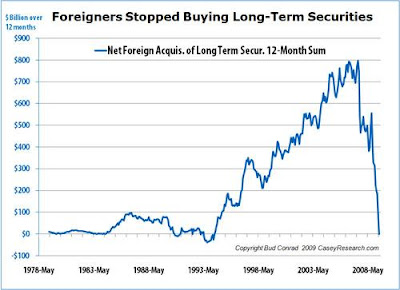Foreign Investment in the U.S. – Going Down, Down, Down
Many of those in the deflation camp largely, or entirely, ignore the potential role these foreign holders may play in the drama now unfolding. But in fact, foreigners have, over the last decade, been by far the single most important source of buying for U.S. Treasuries.
Given the Treasury’s need to flog on the order of $3 trillion worth of its unbacked paper this year just to keep the government’s doors open – and that is a four- or fivefold increase over 2008 – the foreign buyers not only have to show up for the Treasury auctions, they have to show up in droves.
In mid-July, the Associated Press reported that “Foreign demand for long-term U.S. financial assets dropped by the largest amount in four months in May, as Japan and Russia trimmed their holdings of Treasury securities . . . foreigners actually sold $19.8 billion more long-term U.S. securities than they purchased in May. That compared with net purchases of $11.5 billion in April.”
Below you see the big picture of all cross-border flows in May as published by the U.S. Treasury. It shows both foreign investment in the U.S. and U.S. investment abroad. It includes Treasuries, agencies, corporate bonds, equities, and short-term instruments like T-bills. Foreigners bought a lot of T-bills when the credit crisis became acute.

This should be a serious situation with a big drop in foreign investible funds for meeting U.S. borrowing needs. The borrowing by households and business has dropped close to zero, decreasing demand, while government borrowing has jumped but is still smaller than the private borrowing drop. The Fed has added some lending.
A look at just the longer-term Securities (not T-bills) is even more convincing of the slowing of lending by foreigners:
And here is the breakdown of foreign investment into the U.S. Foreigners only continued to buy Treasuries, shunning new investment and selling off agencies in the riskier real estate market.

It’s not for nothing that the Goldman Sachs Secretary of the Treasury Timothy Geithner is hotfooting it around the world lately, last week to Saudi Arabia and the UAE… last month to China.
The purpose of his trip, Geithner told reporters in Paris, he was doing this tour ”to make sure we keep working with governments around the world to continue to provide enough support to lift this global economy back to a sustained pattern of growth.”
But the fact remains that the foreign holders of U.S. dollars have it within their ability – either deliberately or inadvertently as the result of a panic setting in – to literally destroy the U.S. currency.
The latest report shows Russia and longtime monetary ally Japan edging toward the door. China and the oil-exporting nations continue to convert an increasingly moderate amount of their trade surplus into Treasury bills – but not on a nearly large enough scale to meet the inflated (and inflating) borrowing needs of the utterly bankrupt U.S. government. And how long will they continue to show up, when an increasing number of other foreign buyers start selling their Treasuries? No one likes to be the last one to leave a party, especially when the bananas flambé has tipped over on the floor and the curtains are on fire.
Put simply, the only thing now standing between the U.S. dollar holding its own and an almost overnight debasement (and history has shown us that when things go wrong with a currency, they can go wrong very quickly) is the willingness of foreigners to play nice. This was never a threat that the Japanese had to deal with during the worst of their recent dark days, but it’s a very real risk here and now in the United States.
That that risk sits on top of the monetary inflation that has been the steady response of the U.S. government so far – and will continue to be its response as the economy further erodes – is not something to be sniffed at.
On July 17, Bloomberg reported that “China’s finance ministry failed to meet its debt-sale target for a third time in two weeks at a 182-day bill sale, according to traders at Galaxy Securities Co. and China Citic Bank in Beijing. The ministry had tried to sell 20 billion yuan of bills and only sold 18.51 billion yuan, traders said. The average yield for the bills sold was 1.6011 percent, they said.”
There are other alternatives, like getting the People’s Bank of China to print up some new money for the government, which would inflate the renminbi (RMB) and decrease its international price and attractiveness. They might like to let the RMB fall to encourage exports and keep relative worker pay low on the world competitive scene. But they are also trying to make the RMB a world currency by itself, so they don’t want it to look weak and at risk.
Our guess is that they are selling Treasuries and not telling.
[Ed. Note: In latest news this week, Chinese Prime Minister Wen Jiabao said China “will use its foreign exchange reserves to support and accelerate overseas expansions and acquisitions by Chinese companies.” Jiabao called it China’s “going out” strategy. Going out (with a bang), though, may be a better description of what the U.S. will ultimately do.]
This is what The Casey Report, Casey Research’s flagship publication, does: spotting budding trends in the economy and the markets, and then devising ways to profit from them. A strategy that – as thousands of happy subscribers can vouch for – is paying off… and paying off big. Right now, one of our favorite plays, and surest bets, on the economic quagmire we’re in is an investment that is almost guaranteed to be a winner. Let Casey Chief Economist Bud Conrad tell you all about it in his free report. Click here to learn more.


Recent Comments